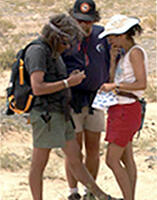
Click the ( + ) signs to explore the items in our scrapbook.

The first step in fossil hunting is finding an area that might be loaded with fossils. Paleontologists often start hunting with binoculars, looking for rocks that have the right color and texture, such as red sandstone cliffs.


fossil hunting
Fossil hunting can be tedious and exhausting. It can be hot and uncomfortable. You might not have enough water, and there may be flies around. There are so many good reasons to quit. Sometimes you’re lucky and the rocks you target are filled with fossils. At other times the rocks have few fossils or none at all.


Where is it?
Collecting fossils involves staring at the ground for hours … and hours … and hours. The team members have found that the more time they spend looking for fossils in the Gobi, the better they become at finding them.

It's hot!
Given the blazing heat, one of the greatest dangers facing paleontologists in the desert is dehydration. What might seem like a leisurely walk down a canyon can become dangerous if one gets caught without enough water to drink.
a new discovery
On a typical day, a lucky paleontologist might find 20 small specimens encased in chunks of rock. More often than not, the identity of the fossils isn’t known until the specimen is cleaned and prepared back at the Museum. Sometimes the finds are better than the scientists imagined; other times, they’re a big disappointment.


deciding what to take home
Paleontologists are very picky about which fossils they jacket and take home, especially the large ones. We only have the time and resources to collect one medium-size dinosaur a year. This means that unless a dinosaur can help answer some pressing research question, it will usually stay in the sandstone.
Image Credits:
All photos, courtesy Discovery Channel Online




 Biodiversity
Biodiversity
 Brain
Brain
 Genetics
Genetics
 Marine BiOLogy
Marine BiOLogy
 MicrobiOLogy
MicrobiOLogy
 PaleontOLogy
PaleontOLogy
 ZoOLogy
ZoOLogy
 AnthropOLogy
AnthropOLogy
 ArchaeOLogy
ArchaeOLogy
 Astronomy
Astronomy
 Climate Change
Climate Change
 Earth
Earth
 Physics
Physics
 Water
Water

